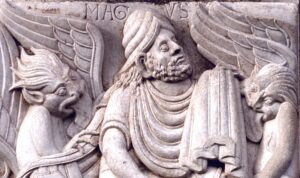
Simon Magus, the magician from Samaria, heralded as “The Great Power of God”, who seduced the people with his sorcery, astonished and captivated them with his self-proclaimed greatness – to whom they all fixed their attention. This same Simon as recorded in Acts 8, was then himself amazed upon the arrival of Phillip who came with the power of Jesus Christ, doing miracles and signs – Simon was then also baptized into the Christian faith. Yet shortly after, he was confronted by Peter for the depth of his sin.
Eventually settling in Rome, Simon seduced the people with his counterfeit brand of Christianity and quasi-apostolic authority, being revered as a god. Rome being where stories & legends have multiplied into various controversies, not the least of which includes Simon Magus confused with Simon Peter.
One story involves the Apostle Peter’s journey to Rome on at least two occasions in a campaign to oppose this impostor who presumed to be the bishop of Rome, which resulted in the death of them both in a dramatic showdown.
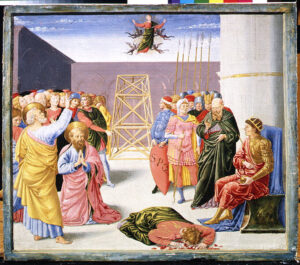
According to some Catholic sources, Simon Magus, in an attempt to demonstrate his power, hurled himself off a tall structure and seemed to be floating in the air while Peter was on his knees praying and commanding the spirits to drop him, whereby Simon fell to his death. When Emperor Nero arrived back in town to learn of the death of his most favored Simon, he ordered Peter to be crucified in his circus.
There are many Catholic paintings which have served to propagate this story, yet the few references documented by the Apostolic Fathers gives just a few sketchy details. One thing for certain, is both figures passed away and each man left a legacy opposed to the other; Yet confused and blended together by many who were disposed to such flimsy fables, the name & Apostolic authority of Peter was mixed & confused with the legend & pagan tradition of Simon Magus in a concoction which developed into the Papacy.
Just as the death of Peter and all the other Apostles by no means marked the end of Christianity, so it was that Simon’s pagan Christianity continued on. Indeed, Roman Catholicism to this day has Simon’s signature written all over it. Much has been documented about this man who has been called ‘the Great Heretic’ and ‘Father of Gnosticism’ with the adverse affects of his hybrid religion of the Babylonian Mysteries blended with elements of the Christian faith.
Backdrop
So much of Roman Catholicism comes to light when reckoning with Simon Magus and his hometown of Samaria:
First off, Samaria was the city which became the capital of the northern kingdom of Israel after breaking away from David’s Kingdom, Judah. Of the northern kingdom of Samaria, King Jeroboam sought to secure his throne with a different religious order, and so led his people into pagan idolatry, which set the precedence for the succeeding kings to do likewise for several generations, until God finally gave them over to the captivity of Assyria.
“Then the king of Assyria brought people from Babylon, Kuthah, Avva, Hamath and Sepharvaim and settled them in the towns of Samaria to replace the Israelites. They took over Samaria and lived in its towns.” –2nd Kings 17:24
After some trial & error, these new inhabitants from different lands decided it would be best if they feared the God of Israel; thus they incorporated the true religion of Yahweh God with the various pagan religions of their own. “So these nations feared the LORD, yet served their idols; their children likewise, and their grandchildren continued as their fathers did, even to this day.” –2nd Kings 17:41
This long standing tradition of such syncretism was the hallmark of Samaria. The amalgamation of different renditions of the Babylonian Mysteries blended with the true religion of Yahweh – distinguished Samaria from the other pagan nations who kept to their own gods.
After a certain number of Israelites returned from exile, their intermingling with the new gentile inhabitants of Samaria caused the escalation of the deep rooted schism between the southern kingdom of Judah and the northern branch of Samaria. The Jews despised the half-breed Samaritans with their corrupted religion, while the Samaritans claimed to be the true descendants of Jacob (John 4:12).
Jesus the Messiah tempered the schism quite well by reaching out to offer salvation to Samaria – while setting the record straight by saying, “You (Samaritans) do not know whom you worship, we (Jews) know Whom we worship, for SALVATION IS OF THE JEWS.” – John 4:22 (emphasis added
So that is the backdrop of this syncretistic system of Samaria which claimed to have the “true religion” – who actually did not even know who they were worshiping. Even so, God offered salvation to those Samaritans who would worship God in spirit and in truth, in which the age-old schism would be healed by the reconciliation of the Jewish Messiah.
Unfortunately Simon Magus would revive the Jewish-Samaritan schism of old with his quasi-christian cult centered in Rome. Yet, his Universal Religion, which was more inclusive and less demanding of complete repentance and true conversion, had great appeal to a broader scope of society. So while this movement decidedly became anti-Jewish (ignoring the very roots of the Christian faith it so claimed), yet became a broad highway for the predominate pagan society of the Roman world.
“I see a ‘gall of bitter poison’ “
To be clear, this was a pagan system under the guise of Christianity; A Babylonian Mystery Cult fused with elements of the Christian faith, with a whole set of doctrines contrary to the the teachings and example of Christ and the Apostles, all while claiming Apostolic authority.
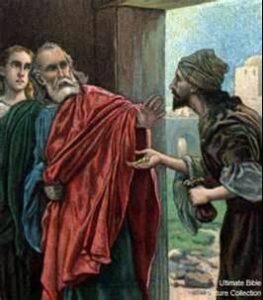
Now we must see how this is exactly what the Apostle Peter had prophesied when confronting Simon as recorded in Acts 8; and I emphasize prophesied – because that is precisely what Peter did, which most readers miss because of what gets lost in translation. So lets take a closer look at Peter’s prophetic confrontation to Simon:
The incident is set off when Simon requests to buy his way into the Apostolic office, only to be opposed by Peter;
“But Peter said to him, “May your silver perish with you, because you thought the gift of God could be purchased with money! You have neither part nor portion in this matter, for your heart is not right in the site of God. Repent therefore of this wickedness and pray God if perhaps the thought of your heart be forgiven you. For I see that you are poisoned with bitterness and bound by iniquity.” – Acts 8:20-23
The last part of Peter’s confrontation is what gets lost in translation, “…For I see that you are poisoned with bitterness and bound by iniquity.” Most translations render this line in similar phrasing which seems to be saying that Simon is a very bitter and sinful person. Yet the original Greek language does not include the word “you” as in Simon (see Lexicon). Instead, a more accurate rendering of the original wording may read something like, “…I see a gall of bitterness and bonds of iniquity”.
Can you see how the latter rendering seems to refer to a condition which is only the beginning of something worse to come – as foreseen by Peter? The typical translation gives the impression that the bitter poison is isolated to just Simon as an individual steeped in deep sin; Yet closer examination reveals a far reaching consequence of such a malignant condition.
Not only that, but Peter uses a well known Jewish idiom – “gall of bitterness”. Without recognizing this particular idiom, so much meaning is missed. Consider idioms of our own English language, like ‘devil’s advocate’, ‘cry wolf’, or ‘close but no cigar’ – think of the certain idea each idiom denotes and how easy it would be to not only lose the intended meaning, but presume something totally different than what was meant – once translated to a different language.
So lets look at the premise of this ‘gall of bitterness’ phrase:
“Make sure there is no man or woman, clan or tribe among you today whose heart turns away from the LORD our God to go and worship the gods of those nations; make sure there is no root among you that produces such bitter poison.” –Deuteronomy 29:18 (NIV)
Another translation of the last part of this passage renders it, “…lest there should be among you a root that beareth gall and wormwood.” (KJV)
Note that the ‘bitter poison’ is referring to idolatry within the assembly of God’s people (very important). Not only does idolatry among God’s congregation leave a bitter tastes in God’s mouth, but infects God’s assembly like an invasive disease. Notice also how this warning addresses the element starting as a root, which is beneath the ground unbeknownst until it crops up with its poisonous fruit to infect the holy assembly of God.
This concept is the premise on which the well known Jewish idiom ‘gall of bitterness’ is derived. It was a figure of speech used along with wormwood to illustrate idolatry among God’s house, and the malignant effects of its poisonous doctrines. Any Jew or Samaritan would have grasped the full meaning of Peters message when he said, “I see a ‘gall of bitterness’ and bonds of iniquity.” And we can see that Simon did indeed recognize Peter’s message of the foretelling consequences of Simon’s infectious condition:
“Then Simon answered and said, “Pray for me, that none of the things you have spoken may come (upon me).” –Acts 8:24
The last words, “upon me” are nowhere to be found in the original language, yet have been inserted to just about every translation (see Lexicon). Again, the wrong idea is given with faulty renderings which give the impression that Peter’s message only pertains to something which will come upon Simon. Yet, according to the words in the original language, Simon’s response may be more accurately rendered as, “Pray for me, that none of the things you have spoken may come.”
Now we can see, only upon closer examination, that Peter is prophesying of the upcoming consequences of the pestilent effect of Simon’s tendencies. Certainly the prophesy pertains to Simon, but is not isolated to him – Peter foresaw the onslaught of a ravaging legacy of poisonous doctrine which carries through this sorcerer of Samaria who desired the power of the Apostolic office.
And now we can see the long standing history of Simon’s legacy of pagan idolatry, sorcery, intrigue for power & domination, bloodshed, mass deception, countless abominations and persecution of the Jews and true saints of God – all in the name of the “True Church”, or “Mother Church”.
Well, “True Church” – no! – but “Mother Church” yes – that is, “Mother of harlots – and the abominations of the earth – Mystery Babylon the Great!” – for more on this see Mystery Babylon – The Luciferian Legacy
Balaam & the Nicolaitans
The next connection we’ll consider has a few details which are not entirely conclusive, yet there is enough to be reasonably confident that the pseudo-christian doctrine associated with Simon Magus is very much connected with the doctrines of the Nicolaitans, the doctrine of Balaam, and the false prophetess – Jezebel – all of which are referred to in Revelation 2-3, in Christ’s address to the seven Church’s.
First off, we must remember that Christ and the Apostles obviously did not deem it necessary to warn the Church about false religious systems outside the Church, for deception in the secular arena was already a given. Rather, the many warnings of deception concentrate on impostors inside the Church – introducing false religious systems of a much more insidious nature. ~ Matthew 7:15, 7:22-23, 24:5, 24:11, 24:24, ~ Acts 20:29 ~ 2nd Corinthians 2:11, 11:13-15 ~ Galatians 1:6-9, 2:4 ~ 1st Peter 5:8 ~ 2nd Peter 2 ~ Jude
With this precedence, we have good reason to conclude that the deceptive doctrines of the Nicolaitans, Balaam, and Jezebel were insidious movements within the Church. Besides that, the descriptions of theses elements detail some degree of interaction within the Church, and it’s obvious these elements were of great consequence to the Church, which would not be the case if they were contained outside the Church, thus they are addressed by Christ Himself.
Second century writers like Irenæus, Tertullian, and Clement of Alexandria indicate that the Nicolaitans were of the Gnostic movement, which definitely connects them to Simon Magus. Now there is nothing conclusive as to exactly who Nicolas actually was; Some believe the name was derived from the same Nicolas who was one of the deacons ordained at Antioch (Acts 6:5), using his good name and authority for their own advancement.
Interestingly, the name Nicolas is the Greek equivalent for the Hebrew name Balaam – both meaning “conqueror of the people”; And it just so happens that the name Nimrod (founder of Babylon), also means the same. So this name “Conqueror of the People” corresponds to the very founder of the Babylonian Mysteries who’s legacy is continued by Balaam, the Nicolaitans and Simon Magus with an updated Christian twist.
Balaam, the sorcerer, lived long before the New Testament era, but we see his legacy of seducing God’s people into idolatry & sexual immorality continues on to serve as a ‘gall of bitterness’ in the Church.
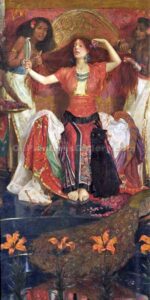
Now, as far as Jezebel, the false prophetess of Thyatira – it’s not likely a coincidence that she went by the same name as the wife of King Ahab, Queen Jezebel, who served as a powerful link in the Babylonian legacy (2nd Kings), who was an anti-type of the female counterpart of Nimrod’s Queen Semiramis. Every student of ancient religion knows that every different rendition of the Babylonian Mysteries always includes great reverence for its grand female deity within the Luciferian godhead, who’s been heralded as the “Queen of Heaven”. For more insight on this, see Is Easter Related to Pagan Goddess Ishtar-Ashtoreth?
So the common denominator between the Nicolaitans, Balaam and Jezebel – is they were of the Babylonian Mystery religion – feigning to be Christian, who’s doctrines were a gall of bitterness.
The Gnostic Movement was just that, and it is well documented how this movement spread like wildfire, originated with Simon Magus, who made his headquarters at Rome, presumed to be the “Bishop of Rome”, was revered as a god, thus elevated his teachings above those of Christ & the Apostles, and passed down by oral tradition. And if any one missed the part where the popes have been revered as “God on Earth”, see Speaking Great Words and Blasphemy.
Constantine
Most people’s understanding of the Paganized Catholic Church only goes as far back as Constantine, who has been given all the credit for paganizing the Roman Church. It must be noted that some degree of pagan elements within the Catholic Church already existed, and Constantine recognized the potential of such an institution to serve the state interest in fostering a more cohesive society. His decision to adopt the Catholic Church as the state religion was that of a shrewd statesman.
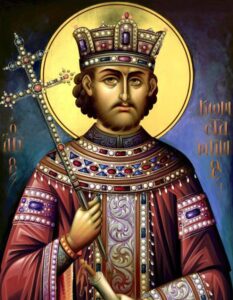
It was not merely Constantine who made the Roman Church what it was; the pagan elements were already rooted beneath the surface by his time, and only needed the opportunity afforded by a state-church union to begin cropping out. Indeed, Constantine certainly gave the Church a big promotion, as it then had the power of the state to back its agendas, which paved the way for corruptions which would escalate to extreme abominations during the medieval times of Papal Rome.
The persecutions of Imperial Rome paled in comparison to the persecutions of Papal Rome, which was enabled by not only religious power, but power of the state. Yes, Constantine empowered the Roman Church to become a political institution which paved the way for supreme power; and yes he did make his own paganizing contribution, but that gall of bitterness already had roots planted at its very origins with Simon Magus.
The Supplanted Church of Rome
It must be clarified that the Roman Catholic Church that we know today or even during medieval times is much different than its beginnings. There is ample evidence in the scriptures alone that the original Church of Rome was a legitimate New Testament Church, and was esteemed for her purity of faith. Some time after Paul’s death, however, that gall of bitterness began to spread its roots. The vigilance of succeeding apostolic fathers kept much of that element in check, but also the persecutions of Pagan Rome kept the Church pure as only those with the most genuine convictions were joining the ranks of the persecuted Church, as they had every earthly thing to lose for their faith in Christ. Thus, the condition of Christianity remained generally pure for the first few centuries.
However, once the persecutions were lifted and a Church/State union was established during the Constantine dynasty, there was more earthly status and wealth to gain with such a promotion, as many nominal believers and false converts joined the faith, bringing with them selfish ambitions and pagan traditions. Such a climate presented the perfect conditions for that root of bitter poison to crop out as the purity of the Catholic Church was indefinitely supplanted by the Simonian-pagan version.
Most so-called “Church History” has mainly focused upon the Catholic Church while ignoring the Remnant Church, who held to the actual teachings and examples of Christ & the Apostles. Yet, whether marginalized or simply explained away as “Heretics”, the obscured yet true New Testament Church has always been a rock-solid reality of history, and despite continual & extreme persecution, has endured throughout the centuries.
There are many more details than what’s been stated in this article, so refer to ‘Related Articles’ and ‘Sources’ for further inquiry.
Related Articles
Simon Magus, What Did He Teach?
St. Peter of Rome is Really Simon Magus the Sorcerer!
Mystery Babylon | The Luciferian Legacy
Is Easter Related to Pagan Goddess Ishtar-Ashtoreth?
The ‘Little Horn’ of Daniel
The Two Beasts | Revelation 13
The Eucharist Strikes the Gospel
Spiritual Warrior | Knowing Our Enemy
Examining the “Seat of Peter” by Examining the Example of Peter
What Happened to the Historic Premillennial View and Historicism?
The Abomination of Desolation – Standing in the Holy Place
Main Sources
– Word & Spirit of God, Who Was and Is and Is to come
– The Apostolic Fathers – The Researchers Library of Ancient Texts Volume 2
– Lactantius – “The Manner in which the Persecutors Died” or alternate text
– Eusebius Pamphilus – “Ecclesiastical History“
– Saint Augustine – “City of God”
– John Clark Ridpath– historian, author ‘Ridpath’s Universal History’
– E H Broadbent – historian, missionary & author of The Pilgrim Church
– Avro Manhattan – authority on Roman Catholicism in politics ‘The Vatican Holocaust‘
– Emanuel M. Josephson – ‘The “Federal” Reserve Conspiracy and Rockefellers’
– Albert Barnes – theologian, “Barnes’ Notes on the Entire Bible
– E. Boyd Barrett – Ex-Jesuit, author of ‘The Jesuit Enigma’
– Peter DeRosa – Catholic Priest, author ‘Vicars of Christ: ‘The Dark Side of The Papacy’
– Charles Spurgeon Archive – 19th century theologian and author
– Adam Clark – theologian bible scholar, “Clark’s Commentary on the Bible“
– Richard Bennet– Christian historian & former Catholic Priest
– John Cornwall – journalist & author of ‘Hitler’s Pope’
– Alberto Rivera – high ranking Jesuit Priest converted to true Christianity
– Ian Paisley – politician and church leader – ‘The Pope is the Antichrist‘
– Augustus Toplady – 18th century theologian & author of ‘The Road To Rome’
– John Foxe – historian & author of ‘Foxes Book of Martyrs’
– Bill Mencarow – theologian & historian
– John Gill – bible scholar “Gill’s Exposition of the Bible“
– Kenneth Scott Latourette – historian, author of ‘A History of Christianity’
– Henry Fliedner – author of ‘The Martyrdom of a People’ or ‘The Vaudois of Piedmont and Their History‘
Web Sources
Fox’s Book of Maryrs – John Fox Historicist.com
‘Hitler’s Pope’ – John Cornwall
The Vatican Holocaust- Avro Manhattan
www.biblebelievers.org/blackpope
Speaking Great Words and Blasphemy
http://biblehub.com/
www.watchmanbiblestudy.com/JesuitInfiltration
The Real Conspiracy- Jesuit Infiltration of Christianity
www.ianpaisley.org/antichrist.asp

